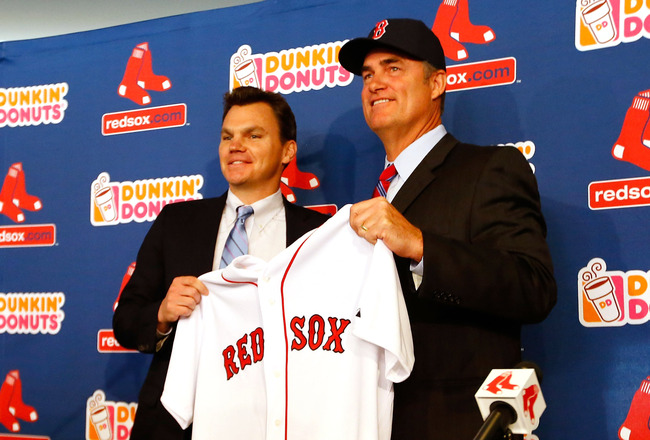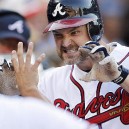
GM Cherington has his man with Farrell but needs to add more help
To say that 2012 was a forgettable season for the Boston Red Sox is an extreme understatement.
The year was marked by an unprecedented rash of injuries to numerous key players, seemingly endless dysfunction and drama centered around manager Bobby Valentine and the blockbuster trade that shed the cumbersome contracts of Adrian Gonzalez, Carl Crawford and Josh Beckett but further depleted a roster that was already about barren. The result was a 69-93 record and a last place finish in the American League East. It was the worst performance by a Red Sox team since 1965, when the club finished 62-100.
Much of last season’s struggles for the Red Sox can be traced to the myriad of injuries to key players. Ineffective starting pitching was detrimental as well. Because of the uncertainty of who the club will acquire via free agency or trade to bolster its lineup and rotation, the consensus among many baseball pundits is that Boston will not be a serious contender in 2013. That is a viewpoint that will be proven wrong.
Here is how the Red Sox can win 95 games next year:
The Healthy Return of Core Players
 David Ortiz, Jacoby Ellsbury, Dustin Pedroia and Will Middlebrooks spent much of the 2012 campaign injured. All four are expected to return fully healthy in 2013.
David Ortiz, Jacoby Ellsbury, Dustin Pedroia and Will Middlebrooks spent much of the 2012 campaign injured. All four are expected to return fully healthy in 2013.
All four are integral parts of the Red Sox lineup. Boston re-signed Ortiz to a two-year extension to serve as the No. 3 hitter. Pedroia battled hand injuries but is expected to be ready by spring training. Middlebrooks had his productive rookie campaign ended early with a fractured wrist. Ellsbury suffered a dislocated shoulder in April and was not at full strength even when he returned late in the summer.
Though Ellsbury will likely depart via free agency after the 2013 season, the Red Sox believe he will be motivated to generate prodigious numbers since he is in a contract year – one that represents the gateway to a monstrous pay day.
Stability With Leadership
When he was Boston’s pitching coach under Francona, Farrell commanded fear and respect from his pitchers, who thrived under his guidance. Critics point to Farrell’s two losing seasons in Toronto, but those same naysayers do not recognize the lackluster talent he was given. Remember, Francona managed several losing teams in Philadelphia before he excelled in Boston. The Red Sox are a better organization than the Blue Jays. Farrell will be provided with the talent to win.
Returning Red Sox players will undoubtedly relish the serenity of Farrell compared to the dysfunction of Valentine. Farrell has added bench coach Torey Lovullo and third base coach Brian Butterfield from his staff in Toronto. Lovullo and Butterfield are well-liked and both are considered future Major League managers. Butterfield is a a New England native and Lovullo formerly managed Triple-A Pawtucket before joining Farrell’s staff with the Blue Jays.
New pitching coach Juan Nieves has extensive experience as a minor league pitching coach and has spent the last decade working under Don Cooper with the White Sox. Cooper is regarded as one of the best pitching minds in baseball.
The Red Sox retained bullpen coach and catching instructor Gary Tuck, who is widely respected around baseball and is well-liked by current Red Sox players.
Though it is true that managers and coaches can’t shut down opposing lineups and deliver a timely hit with runners in scoring position, having stability in the dugout and the clubhouse is crucial for a team as the Red Sox learned the hard way in 2012.
Substantial Payroll Flexibility
 Thanks to the Los Angeles Dodgers – who removed the burden of the costly long-term deals of Gonzalez, Crawford and Beckett – the Red Sox entered the offseason with less than $40 million in payroll commitments towards the luxury tax threshold. Some of that has been reduced by the signing of Ortiz – and the two-year, $6.2 million deal given to catcher David Ross – yet the Red Sox have a multitude of options for acquiring players since they are a large market team.
Thanks to the Los Angeles Dodgers – who removed the burden of the costly long-term deals of Gonzalez, Crawford and Beckett – the Red Sox entered the offseason with less than $40 million in payroll commitments towards the luxury tax threshold. Some of that has been reduced by the signing of Ortiz – and the two-year, $6.2 million deal given to catcher David Ross – yet the Red Sox have a multitude of options for acquiring players since they are a large market team.
Red Sox general manager Ben Cherington has said the club will be cautious about signing free agents to long-term deals, avoiding the blunders since departed general manager Theo Epstein made with Crawford, John Lackey and J.D. Drew among others. Instead, Cherington prefers to sign free agents to short-term contracts and acquire young players who are under team control and not nearing free agency.
Still, because Boston needs two outfielders, a first baseman and a starting pitcher – and they have an ample amount of money to spend before approaching the luxury tax threshold – the organization could fill at least one of those vacancies with a big contract free agent.
Pitching, Pitching, Pitching
 Yes, the Red Sox starting rotation has been ineffective the last two seasons, especially in 2012 when Jon Lester had his worst year as a Major Leaguer. Yet the club’s rotation could be a plus in 2012 with Lester, Clay Buchholz (who showed how dominant he can be with his performance after the All-Star break), Felix Doubront and Lackey.
Yes, the Red Sox starting rotation has been ineffective the last two seasons, especially in 2012 when Jon Lester had his worst year as a Major Leaguer. Yet the club’s rotation could be a plus in 2012 with Lester, Clay Buchholz (who showed how dominant he can be with his performance after the All-Star break), Felix Doubront and Lackey.
Though Lackey has been a disappointment in the first three years of his costly five-year, $82.5 million deal, he pitched with a balky elbow for three years before undergoing Tommy John surgery in late October 2011. When he reports to spring training, Lackey expected to be fully recovered. When healthy, Lackey is a workhorse. The Red Sox are curious to see how he will perform now that his elbow issue is resolved. He could be a valuable back of the rotation piece.
Lester and Buchholz have top of the rotation stuff when they are right, and Farrell’s return should help. Doubront, a 25-year-old left-hander, wore down towards the end of his rookie campaign in 2012, but he showed flashes of dominance, especially against the Yankees.
The Red Sox will likely get a durable arm to add to the rotation. Also, for the first time in several years, the team will have promising starting pitching prospects a phone call away at Triple-A Pawtucket. The club is high on Rubby De La Rosa and Allen Webster, who were acquired from the Dodgers in last summer’s trade, as well as 2011 first round pick Matt Barnes, who might open the 2013 season at Double-A Portland and then earn a promotion to Pawtucket during the year.
Franklin Morales and Alfredo Aceves will probably open the 2013 season in the Red Sox bullpen, but both pitchers have shown that they have promise in the rotation.
Wrapping It Up
As it is currently composed, the Red Sox roster needs another reliable starting pitcher; and productive bats at first base and in the corner outfield spots, before the team can be considered a legitimate postseason contender.
With the available payroll; the returning core players; promising prospects like the aforementioned pitchers and position players like Xander Bogaerts, Ryan Kalish and Bryce Brentz about Major League ready; and the inevitable trades and free agent signings to upgrade the lineup and pitching staff, the Red Sox can feasibly win 95 games in 2013 and secure a postseason spot.
The Red Sox are not a small market team, and their roster is not fully void of talent. The club just needs some enhancements here and some tinkering there. This is the time for Cherington to show the depth of his baseball mind. Like Epstein did for Boston in 2003 and 2004, Cherington has an opportunity to craft a pennant winner with the right moves.
